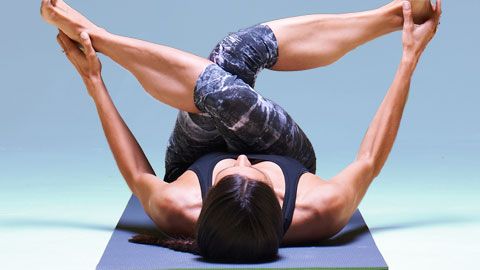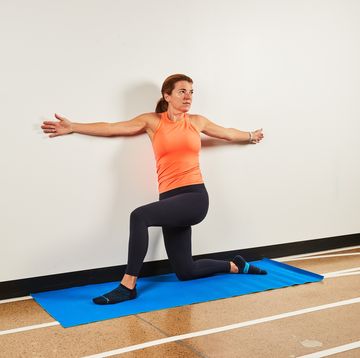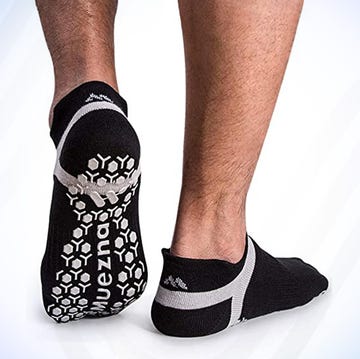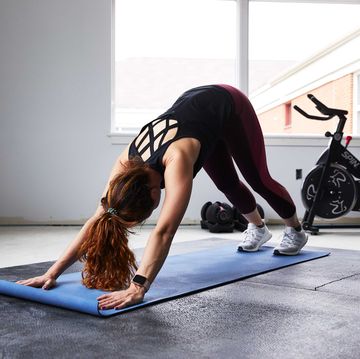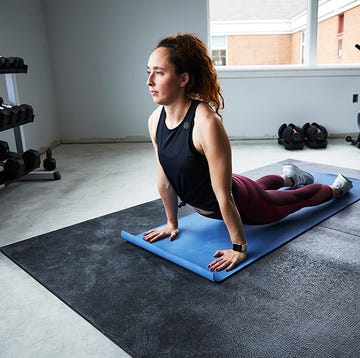When sciatica pain strikes, it can be tempting to stay sedentary out of fear that you might make the flare-up worse. Yet moving your body slowly and gently can be one of the best ways to ease your symptoms, says Jamie Elmer, ERYT-500, a yoga teacher in Grand Junction, Colorado, and a Yoga Alliance continued education provider.
Just check in with a doctor before hitting your yoga mat: “Before you do just any stretch or yoga pose, it helps to have a sense of what’s causing your sciatica pain,” advises Elmer. (Here are 5 Health & Injuries.)
Typically, sciatica symptoms can be traced back to two different reasons, she says. One of the most common causes is Piriformis Syndrome, which happens when the piriformis—a small muscle deep in your hips that externally rotates (turns out) your thighs—becomes tight and compresses the sciatic nerve, leading to a pain in your butt—literally. The other main cause of sciatica is compression in the spine, usually between the L4 and L5 vertebrae (the lowest two vertebrae in your lumbar spine, or lower back), that can lead to the disc between those vertebrae bulging (or herniating) and compressing the sciatic nerve.
RELATED: A Part of Hearst Digital Media Runner’s World Yoga workout!
“If your issues stem from Piriformis Syndrome, exercises that stretch the piriformis and encourage an internal rotation of your thighs can take some of the “tightness” out of the piriformis and lessen your pain,” says Elmer.
The 10 Best Yoga Socks:
Prone Reverse Clam
This exercise is ideal for those who “live” with their thighs in external rotation, says Elmer. To tell if you do this, stand in front of a mirror and look at your knees. Do they point straight ahead, or are they slightly turned out? If they’re turned out, this gentle move will help to bring your thighs back to parallel, helping to ease the pressure external rotation puts on your piriformis.
How-to:
- Stay here for 10 slow breaths, or for at least 1 minute on each side.
- Bend your knees, and let your feet move out toward either side of your hips; then, internally rotate your thighs to bring them back to parallel.
- Do 5-10 reps total.
Other Hearst Subscriptions.
Cow Face Variation
This is a deeper stretch for the piriformis, which can help to relieve any pressure it might be putting on your sciatic nerve. (You can also Other Hearst Subscriptions.)
How-to:
- Lie on your back with your knees bent, one thigh over the other. Bring your knees in toward your chest, holding onto your knees. For a deeper stretch, hold on to your feet.
- Things Only People With Sciatica Understand.
Pigeon Variation
This pose can help you feel a release of tension in the entire butt, as well as the low back. “The traditional Pigeon Pose, where the back leg is stretched out straight behind you, is too hard on many people’s knees,” says Elmer. “In this modified version, we stretch the piriformis while also keeping it safe for most people.”
How-to:
- From a lunge position, with your right foot in front, left knee and both hands on the ground, walk your right foot over toward your left hand, then drop your right shin and thigh to the ground.
- Keeping your left thigh bone out to the side, bend your left knee and bring your left foot in toward your butt. Lean over your front leg and thigh, fingertips on the ground, breathing deeply for 10 slow breaths.
- Switch sides and repeat.
RELATED: 6 Reasons Your Yoga Instructor Needs to Know You’re a Runner
Forward and Side Lunges
When the gluteus maximus, medius, and minimus—a.k.a. the butt muscles—aren’t strong, the piriformis tends to work overtime and become tight as a result, says Elmer. “When we strengthen the glutes, the piriformis is less likely to ‘take over.’” These lunges help to strengthen the glutes and get them working in balance with the piriformis. (Try this other Running Shoes & Gear Best Big City Marathons.)
How-to:
Forward Lunge
- Switch sides and repeat.
- Holding the desk lightly with both hands, slide your right foot back as you bend your left knee, keeping your left knee directly above your left ankle. (To slide easily, wear a sock on the foot that is moving.) When your right knee touches the ground, slide back to the starting position.
- Things Only People With Sciatica Understand.
Side Lunge
- Start in a similar position, standing in front of a desk, and slide your right leg out to the right side (not behind you), bending your left knee and keeping it directly above your left ankle.
- Runners World Yoga.
Press Ups
This move helps to open the space at the spinal level where the sciatic nerve moves through the spine and between the discs, says Elmer, which means it decompresses the spine and makes space for the nerve. (Prevent sciatica aches with this pain-relief pillow Amazon users swear by for better sleep.)
How-to:
- Lie on your stomach with your palms on the ground, slightly in front of your shoulders and a few inches to either side.
- Inhale; then, as you exhale, gently push into the ground with your hands to lift yourself up into a low Cobra Pose. “Coming up on an exhale is important, as it prompts you to use your abdominal muscles, which helps to support your spine in this gentle backbend,” says Elmer.
- On your next inhale, return to starting position. Repeat 10 to 15 times.
MORE: 7 Sales & Deals
Walking Backward
While this isn’t technically a yoga pose, Elmer says it’s amazingly simple and beneficial when it comes to easing sciatica symptoms. “I’ve seen this bring immediate relief,” she says. Many people with sciatica symptoms tend to hold their pelvis in what’s called a posterior tilt—or 'tucked under'—which leads to a diminished curve in the lumbar spine and causes disc compression as a result. “Walking backward stretches the hip flexors and helps the low back move into a more natural extension, which helps to release pressure on the sciatic nerve,” says Elmer.
How-to:
- Find an open space and check behind you to make sure there aren’t any obstacles in the way, which could cause you to stumble.
- Now simply walk backwards for 100 yards or more, periodically checking to make sure your path is clear.
The article Races & Places Flex, bend, and stretch your way to injury-free running with the Prevention.

